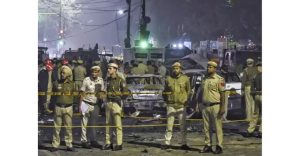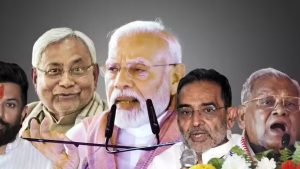
dian state politics, with the ruling National Democratic Alliance (NDA) headed by the Narendra Modi-led Bharatiya Janata Party (BJP) and its partner Janata Dal (United) (JD(U)) registering a sweeping victory. Early trends indicate that the alliance is set to cross the 200-seat mark in the 243-member assembly — a feat not seen since 2010.
A decisive mandate
By midday on result-day the NDA was already leading in approximately 188 seats. JD(U) was showing a lead in around 75 seats, while the BJP was ahead in about 85 seats. Smaller allied parties like the Lok Janshakti Party (Ram Vilas) (LJP-RV) and the Hindustani Awam Morcha (HAM) added further strength. The opposition coalition (the Mahagathbandhan) trailed far behind, signalling a sharp shift in voter sentiment.
Why the NDA surge?
Several inter-locking factors explain the scale of this win.
1. Strategic alliance and seat-sharing
The NDA’s pre-poll preparations stood out. The BJP and JD(U) contested nearly equal numbers of seats (around 101 each), a clear gesture of parity and coordination. Smaller allies were allocated constituencies where they had stronger local presence. This avoided internal friction and vote-splitting, something that has plagued coalitions in the past.
2. Broadening the social coalition
The NDA moved beyond its traditional upper-caste base by consolidating support among economically backward classes (EBCs), Dalits, women and first-time voters. The JD(U)’s strong presence among Kurmis and backward castes complemented the BJP’s upper-caste and youth outreach. This overcame the narrow “Muslim-Yadav” axis that dominated previous Bihar contests and allowed the NDA to capture nearly 49 % of the vote in many estimates, compared with the opposition’s 38 %.
3. Women’s turnout and welfare outreach
Women voters proved decisive. In many districts women’s turnout exceeded men’s by 10-20 percentage points. The NDA’s narrative of welfare linked to women (self-help groups, direct benefit transfers, livelihood support) resonated strongly. The coordination by state machinery — including deployment of women volunteers (“Jeevika Didis”) to guide women voters — also helped.
4. Governance credentials and fear of regression
The electorate appeared motivated by continuity of governance rather than change for its own sake. The NDA successfully revived the “jungle raj” narrative — harking back to lawlessness in past decades under previous regimes — juxtaposing that with its own promise of stability, infrastructure and development. The governance record of Nitish Kumar as Chief Minister, along with the national reach of PM Modi, gave the alliance credibility among voters seeking order and economic opportunity
5. Youth and first-time voters
While youth unemployment and migration remain big challenges in Bihar, many young voters appeared persuaded by the alliance’s developmental message rather than opting for newer entrants in the political arena.
Implications for Bihar and beyond
This mandate has both state and national implications.
In Bihar, the NDA’s large majority paves the way for an uninterrupted term and provides a strong hand to Chief Minister Nitish Kumar. The alliance’s dominance may allow more aggressive policy implementation on infrastructure, industry, job creation, and improved delivery of welfare schemes. Industry leaders have already hailed the result as a boost for investment and growth in Bihar.
Nationally, the result offers a significant political shot in the arm for the NDA, re-affirming that PM Modi’s leadership remains potent in the Hindi-heartland. According to the Associated Press, the win reinforces the alliance’s grip ahead of other crucial state polls, and even the next general election. The result may influence party strategies, caste arithmetic, welfare roll-out and voter targeting in other states.
For the opposition, the result raises urgent questions. The Mahagathbandhan’s poor showing signals a breakdown in its ability to translate mobilisation into wins, especially when up against a surge combining welfare, women, and caste coalitions. The failure of newer contenders to break through suggests that simply being an “alternative” is no guarantee of success unless supported by organisation and ground presence.
What to watch next
- Seat distribution and margin details: As the counting completes, watching how many seats the NDA wins, and by what margins, will indicate the depth of its mandate.
- Policy follow-through: Whether the NDA converts the mandate into accelerated growth in Bihar — in job creation, infrastructure, industries — will determine whether this win leads to sustained gains.
- Opposition reorganisation: How the opposition strategises in response — revisiting alliances, leadership, caste strategy and outreach — will shape the next horizon of Bihar politics.
- National ripple effects: Whether the playbook used in Bihar (women/welfare/caste coalition) is replicated elsewhere, and what that means for the 2029 general election, will be a key story.
Conclusion
The 2025 Bihar assembly election appears to have awarded the NDA not just a win, but a decisive mandate. By crafting a broad coalition, prioritising women and welfare, and leveraging its governance narrative, the alliance appears to have reinforced its dominance in one of India’s most politically consequential states. For voters, the verdict seems to reflect a preference for continuity, development and stability. For the rest of India’s party system, it marks a moment of reckoning.







